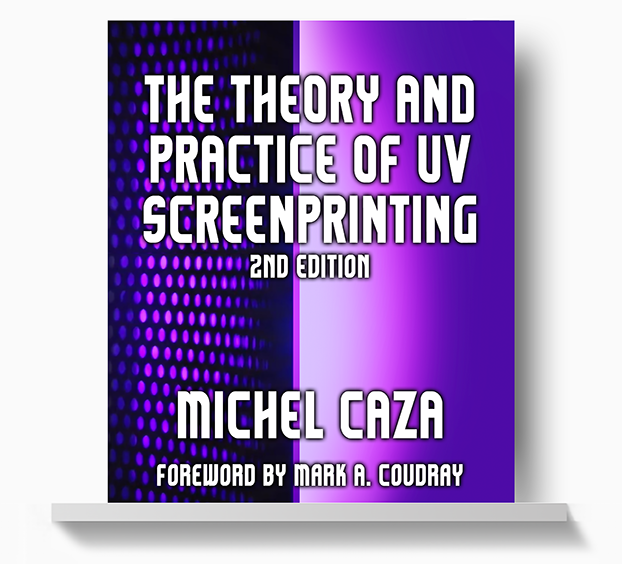Welcome to the second edition of The Theory and Practice of UV Screenprinting. The original has been used as not only an introduction to ultra-violet screenprinting but also for those who wanted to take their printing skills to the next level. Within the 204 pages, you will find 23 chapters with a comprehensive study of UV screenprinting from the Master Printer of Fine Arts, Michel Caza, with over 350 awards for his work printing several thousand original serigraphs for artists worldwide.
The table of contents below shows how well the book covers the entire process of UV screenprinting.
Chapter 1: What is UV Printing?
Drying or Curing
UV Inks
Change of Condition
Chapter 2: The Theory of UV
Theory Basis
UV Wave Length
Parasitic Radiation
Chapter 3: UV Radiation: How Does It Work?
Curing
UV Inks
Chapter 4: Action and Effect of Photoinitiators
Photoinitiator Role
Absorption Characteristics
Pigments
Reaction Speed
Incidental Factors
Chapter 5: The “Center of Reaction”
Inert Atmosphere
Advantages (theoretic)
Disadvantages
Oxygen Inhibition
Minimum Ink Deposit
Polymerization
Chapter 6: The Additives
Classical Additives
Thixotropy
Shelf Stability
Viscosity Adjusters
Liquid Monomers
Chapter 7: Other Factors Influencing the Reaction: The Pigments
Curing Speed
Transparent UV Inks
Chapter 8: Incidence of the “UV Factor” on the Characteristics of Inks
No influence of the UV factor
Some influence of the UV factor
Resistance
Flexibility
Adhesion
Ink Mileage
The total influence of the UV factor
Chapter 9: What Produces UV Radiation?
Surface Coverage = form of the lamp
Predominating Lamps
Chapter 10: The Lamps
Reactivity
Mercury Vapor
Pulsed Xenon
Quartz Lamps
UV-LEDs
Wavelength Cocktail
Lamp Life
Heating and Cooling
Hyper Frequency Generation
Chapter 11: The Reflectors
Distance and Focalization
Elliptical Reflector
Oxidization
Chapter 12: Additional Problems
Emitted Heat
Cooling by Air Alone
Cooling by water circulation around the reflector
With the Addition of a Heat Pump
Cooling Units
UV-LEDs lamps
Start and restart times of the lamps
Ozone production
How to eliminate this ozone?
Eye and skin protection
The conveyor belt
Chapter 13: Advantages and Disadvantages of UV Inks
A. Technical and screenprinting advantages
B. Economic Advantages
C. Technical and Screenprinting Disadvantages
D. Economic Disadvantages
Chapter 14: Advantages and Disadvantages of UV Curing Units
A. Technical and Screenprinting Advantages
B. Economic Advantages
C. Technical Disadvantages
Chapter 15: What can and cannot be printed with UV
What We Cannot Print With UV
Halftone and Four-Color Printing
Printed Circuits and object printing
Substrates
Substrate Size
What We Can Print
Chapter 16: 18 Misconceptions about UV
Chapter 17: The “Three Big Questions” About UV
A. Whether to Accept or Reject UV
Shop Size
B. Is UV Printing “Qualitatively” and “Commercially” Satisfactory?
C. What Exactly Does UV Technology Mean to Modifications of Materials, Products, and Training in the Plant?
1. Equipment
2. Materials
3. Training
Chapter 18: The Choice of Mesh
UV Calendered Meshes
Chapter 19: ScreenMaking (Stencils)
The direct-indirect method
The Direct Method
The Indirect Method
Capillary Films
Chapter 20: The Halftone Plate (Stencil) For UV Printing
100 lines/inch fabric on macro-porous substrates
100 Lines/Inch on porous substrates
100 Lines/Inch on slightly porous substrates
100 Lines/Inch on microporous substrates
Chapter 21: Printing
The Fill (Flood) Blade
The Squeegee
Printing Speed
Cover Ink During Long Breaks
Chapter 22: Hygiene and Worker Protection
Risks with the UV Curing Unit
Risks Involving the UV Inks
Chapter 23: General Advice
What’s New
This edition has been extensively edited and rewritten by the author, Michel Caza, to bring the information current. The original illustrations were updated, and new ones added. And there is a Foreword written by Mark A. Coudray.
About the Author
Michel Caza entered the screenprinting field in the mid-1950s.
He has created several companies in France and has printed several thousand original serigraphs for artists worldwide. Michel has received more than 350 awards for his work in many screenprinting applications. He is considered a master printer of fine arts.
He is responsible for many technological advancements in UV technology and inks, fine line half-tone printing, continuous tone printing, superpositions of transparent inks, and textile printing.
In 1962, Michel became a “founding father” when FESPA (Federation of European Screen Printers Association) was formed as a ‘non-profit’ organization by a group of screenprinting associations whose aim was to create a platform to share knowledge on screenprinting technology in Europe.
Michel was also the recipient of a Lifetime Member of the Specialty Graphics and Imaging Association (SGIA), which has changed its name to Printing United Alliance.
In 1981 Michel won the prestigious Academy of Screen & Digital Printing Technology’s Swormstedt Award for Excellence in Technical Writing for The Theory and Practice of UV Screenprinting.
Michel’s peers inducted him into the Academy of Screen & Digital Printing Technology in 1982. He received the Howard Parmele Award, the highest distinction of the Specialty Graphics and Imaging Association (SGIA), in 2010.
Product Details
Format: Adobe PDF
File Size: 13.5 MB
Print Length: 204 pages
Publisher: Solutions Publishing
Sold by: ScreenprintBooks.com
Language: English
Lending: Disabled
Editing: Disabled
Author: Michel Caza
Please read Our Policies page before purchasing our products. There are no refunds offered for digital products. Please read the description to assure that you understand what you are purchasing. If you have any pre-purchase questions regarding the item, we will be happy to answer them.
